Class 6 Maths Chapter 4 Data Handling and Presentation Solutions
Data Handling and Presentation Class 6 Solutions Questions and Answers
4.1 Collecting and Organising Data Figure it Out (Page No. 75 – 76)
Question 1.
What would you do to find the most popular game among Naresh’s and Navya’s classmates?
Solution:
To find the most popular game, we should create a table with two columns, one for the game name and one for the number of students who choose each game. By referring the Naresh’s and Navya’s list, for each game count how many students selected it and record that number in the table. The game with the highest count will be the most popular game.
Question 2.
What is the most popular game in their class?
Solution:
Most popular game in the class is Hockey as it is liked by maximum number of students.
Question 3.
Try to find out the most popular game among your classmates.
Solution:
Do it yourself. [To find the most popular game among your classmates, collect the data from each student about his/her favourite game. Game liked by maximum number of students is the most popular game in your class.]
Question 4.
Pari wants to respond to the questions given below. Put a tick (✓) for the questions where she needs to carry out data collection and put a cross (✗) for the questions where
she doesn’t need to collect data. Discuss your answers in the classroom.
(a) What is the most popular TV show among her classmates?
(b) When did India get independence?
(c) How much water is getting wasted in her locality?
(d) What is the capital of India?
Solution:
Do it yourself.
4.1 Collecting and Organising Data Figure it Out (Page No. 76 – 77)
Question 1.
Complete the table to help Shri Nilesh to purchase the correct numbers of sweets:
Solution:
From the given table, number of students against Jalebi is 6. Therefore, 6 students chose Jalebi.
- The tally marks for Barfi is

that represents 3 students. Therefore, Barfi was chosen by 3 students. - The tally marks for Gujiya is

that represent 13 students. Therefore, 13 students chose Gujiya. - The tally inarms for Rasgulla is

that represent 7 students. Therefore, Rasgulla was chosen by 7 students, 9 students chose Gulab Jamun.
Question 2.
Is the above table sufficient to distribute each type of sweet to the correct student? Explain. If it is not sufficient, what is the alternative?
Solution:
No, the table is not sufficient to distribute each type of sweet to the correct student. The table only shows the total number of students who like each sweet but does not specify which individual prefer which sweet.
To ensure each student receives the correct sweet, we need a more detailed list that includes each student’s name along with their preferred sweet.
4.1 Collecting and Organising Data Figure it Out (Page No. 77 – 79)
Question 1.
Help her to figure out the following:
- The largest shoe size in the class is __________.
- The smallest shoe size in the class is __________.
- There are __________ students who wear shoe size 5.
- There are __________ students who wear shoe sizes larger than 4.
Solution:
- The largest show size in the class is 7.
- The smallest shoe size in the class is 3.
- There are 10 students who wear shoe size 5.
- There are 15 students who wear shoe sizes larger than 4.
Question 2.
How did arranging the data in ascending order help to answer these questions?
Solution:
Arrangement of data in ascending order enables us to •find the smallest shoe size, the largest shoe size and the shoe sizes lying between them.
Question 3.
Are there other ways to arrange the data?
Solution:
Yes, the given data can also be arranged in descending order.
Question 4.
Write the names of a few trees you see around you. When you observe a tree on the way from your home to school (or while walking from one place to another place), record the data and fill in the following table:
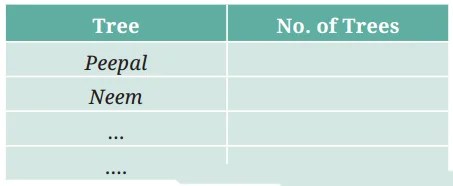
(a) Which tree was found in the greatest number?
(b) Which tree was found in the smallest number?
(c) Were there any two trees found in the same numbers?
Solution:
Do it yourself.
Question 5.
Take a blank piece of paper and paste any small news item from a newspaper. Each student may use a different article. Now, prepare a table on the piece of paper as given below. Count the number of each of the letters V, ‘f, V, and ‘x’ in the words of the news article, and fill in the table.

(a) The letter found the most number of times is __________
(b ) The letter found the least number of times is __________
(c) List the five letters ‘c’, ‘e’, ‘i’, ‘r’, ‘x’ in ascending order of frequency. Now, compare the order of your list with that of your classmates. Is your order the same or nearly the same as theirs? (Almost everyone is likely to get the order ‘x, c, r, i, e’.) Why do you think this is the case?
(d) Write the process you followed to complete this task.
(e) Discuss with your friends the processes they followed.
(f) If you do this task with another news item, what process would you follow?
Solution:
Do it yourself.
InText Questions (Page 80)
Question 1.
Which mode of travel is used by the most number of students?
Answer:
In the table given on Page 79, the number of symbols for school bus is maximum. Therefore, school bus is used as mode of travel by the most number of students.
Question 2.
Which mode of travel is used by the least number of students?
Answer:
In the table, given on Page 79, the number of symbols for cycle is minimum. Therefore, cycle is used as mode of travel by the least number of students.
4.2 Pictographs Figure it Out (Page No. 83 – 84)
Question 1.
The following pictograph shows the number of books borrowed by students, in a week, from the library of Middle School, Ginnori —

(a) On which day were the minimum number of books borrowed?
(b) What was the total number of books borrowed during the week?
(c) On which day were the maximum number of books borrowed? What may be the possible reason?
Solution:
(a) In the table, there is no picture for Thursday. This means on Thursday the minimum number of books were borrowed.
(b) There are total 24 pictures in the table and 1 picture = 1 book. Therefore, total 24 books were borrowed during the week.
(c) In the table there are maximum number of pictures for Saturday. Therefore, maximum number of books were borrowed on Saturday.
The maximum number of books borrowed on Saturday might by because people have more free time to read or study over weekend.
Question 2.
Magan Bhai sells kites at Jamnagar. Six shopkeepers from nearby villages come to purchase kites from him. The number of kites he sold to these six shopkeepers are given below:
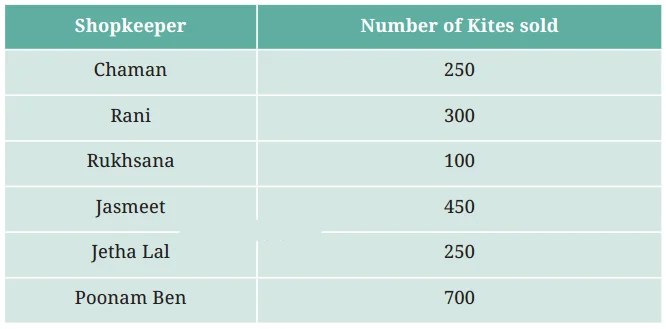
Prepare a pictograph using the symbol to represent 100 kites.
Answer the following questions:
(a) How many symbols represent the kites that Rani purchased?
(b) Who purchased the maximum number of kites?
(c) Who purchased more kites, Jasmeet or Chaman?
(d) Rukhsana says Poonam Ben purchased more than double the number of kites that Rani purchased. Is she correct? Why?
Solution:
Pictograph.
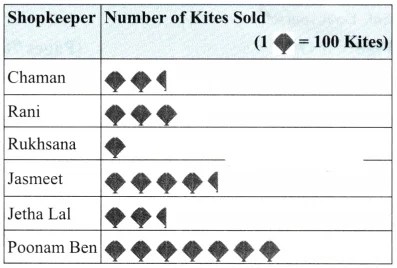
(a) 3 symbols represent the kites that Rani purchased.
(b) Poonam Ben purchased the maximum number of kites.
(c) In the pictograph number of symbols for Jasmeet is more than the number of symbols for Chaman. Therefore, Jasmeet purchased more kites than Chaman.
(d) Yes, Rukhsana is correct.
Kites purchased by Poonam Ben = 700 Kites purchased by Rani = 300 Double of 300 is 600. Clearly, 700 is more than 600. Hence, Poonam Ben purchased more than double the number of kites that Rani purchased.
InText Questions (Page 86)
Answer the following questions using the bar graph:
Question 1.
In Class 2, _______ students were absent that day.
Solution:
In Class 2, 5 students were absent that day.
Question 2.
In which class were the maximum number of students absent? _______
Solution:
The bar for class 8 is the highest. Therefore, in class 8, maximum number of students were absent.
Question 3.
Which class had full attendance that day? _______
Solution:
There is no bar for class 5. It means bar length for class 5 is 0. Therefore, class 5 had full attendence that day.
4.3 Bar Graphs Figure it Out (Page No. 88)
Question 1.
How many total cars passed through the crossing between 6 am and noon?
Solution:
Total number of cars which passed through the crossing between 6 am and noon = 150 + 1200 + 1000 + 820 + 700 + 600 = 4470 (Refer the bar graph on page 87)
Question 2.
Why do you think so little traffic occurred during the hour of 6-7 am, as compared to the other hours from 7 am-noon?
Solution:
During 6-7 am time duration, little traffic occured as compared to other hours from 7 am-noon, because during 6-7 am, there were less people going to their work.
Question 3.
Why do you think the traffic was the heaviest between 7 am and 8 am?
Solution:
Traffic was heaviest between 7 am and 8 am as there were more people using their vehicles to reach their office or work place. Also, there are many school buses carrying children to their school.
Question 4.
Why do you think the traffic was lesser and lesser each hour after 8am all the way until noon?
Solution:
Traffic was laser each hour after 8 am all the way untill noon, because there were no school buses on road. Also, number of people going to their work place is decreasing continuously.
InText Questions (Page 93)
Use the bar graph (page 92) to answer the following questions:
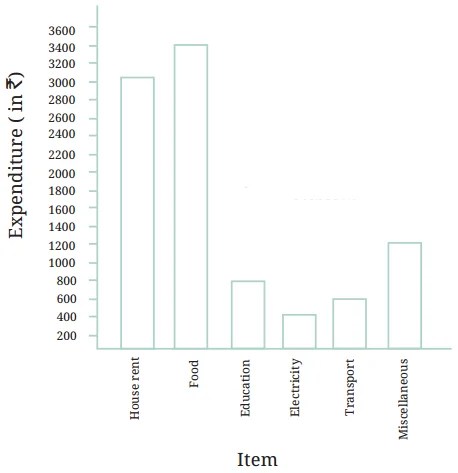
Question 1.
On which item does Imran’s family spend the most and the second most?
Solution:
The highest bar is for food and the second highest is for the house rent. Therefore, Imran’s family spends the most on food and the second most on house rent.
Question 2.
Is the cost of electricity about one-half the cost of education?
Solution:
In the bar graph, the height of the bar for electricity is 400 and the height of the bar for education 800. Therefore, the cost of electricity is one-half the cost of education.
Question 3.
Is the cost of education less than one-fourth the cost of food?
Solution:
In the bar graph, the height of the bar for food (3400) is more than 4 times the height for the bar for education (800). Therefore, the cost of education is less than one- fourth the cost of food.
4.4 Drawing a Bar Graph Figure it Out (Page No. 93-99)
Question 1.
Samantha visited a tea garden and collected data of the insects and critters she saw there. Here is the data she collected

Help her prepare a bar graph representing this data.
Solution:
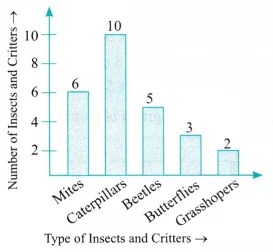
Question 2.
Pooja collected data on the number of tickets sold at the Bhopal railway station for a few different cities of Madhya Pradesh over a 2-hour period.

She used this data and prepared a bar graph on the board to discuss the data with her students, but someone erased a portion of the graph.

(a) Write the number of tickets sold for Vidisha above the bar.
(b) Write the number of tickets sold for Jabalpur above the bar.
(c) The bar for Vidisha is 6 unit lengths and the bar for Jabalpur is 5 unit lengths. What is the scale for this graph?
(d) Draw the correct bar for Sag5r.
(e) Add the scale of the bar graph placing the correct numbers on the vertical axis.
(f) Are the bars for Seoni and Indore correct in this graph? If not, draw the correct bafts).
Solution:
(a and b)
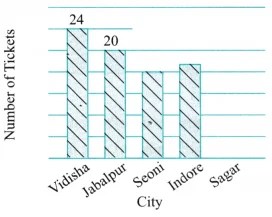
(c) For Vidisha, bar length is 6 units, number of tickets 24. Therefore, scale = 24 ÷ 6 = 4 tickets per unit.
For Jabalpur, bar length is 5 units, number of tickets 20. Therefore, scale = 20 ÷ 5 = 4 tickets per unit.
Hence, the scale for this graph is 1 unit = 4 tickets.
(d)

The bar for Seoni was correct but the bar for Indore was incorrect. Following is the correct graph.
(e – f)
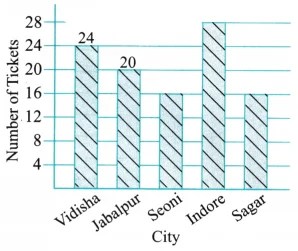
Question 3.
Chinu listed the various means of transport that passed across the road in front of his house from 9 am to 10 am:
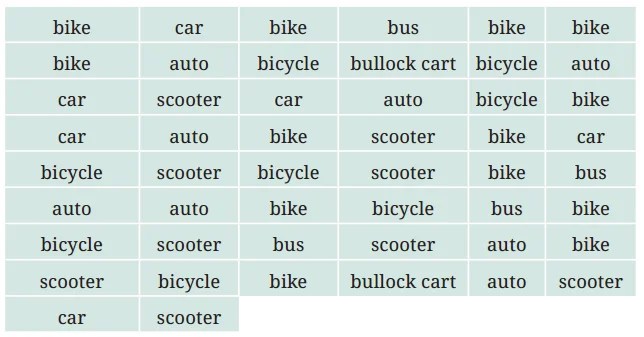
(a) Prepare a frequency distribution table for the data.
(b) Which means of transport was used the most?
(c) If you were there to collect this data, how could you do it? Write the steps or process.
Solution:
(a) Frequency Distribution Table

(b) Bike
(c) Step 1: Note down the name of various means of transport in the notebook.
Step 2: Between 9 am to 10 am, watch the different means of transport passing in front of the house.
Step 3: Write the number of different means of transport in front of their name.
Question 4.
Roll a die 30 times and record the number you obtain each time. Prepare a frequency distribution table using tally marks. Find the number that appeared:
(a) The minimum number of times.
(b) The maximum number of times.
(c) Find numbers that appeared an equal number of times.
Solution:
Do it yourself.
Question 5.
Faiz prepared a frequency distribution table of data on the number of wickets taken by Jaspreet Bumrah in his last 30 matches:

(a) What information is this table giving?
Solution:
The table is giving information about number of wickets taken by Jaspreet Bumrah in his last 30 matches.
(b) What may be the title of this table?
Solution:
Title of the given table could be “Number of wickets taken by Jaspreet Bumrah”.
(c) What caught your attention in this table?
Solution:
Out of 30 matches, Jaspreet Bumrah has taken 5 wickets in a match 5 times i.e. in 5 matches.
(d) In how many matches has Bumrah taken 4 wickets?
Solution:
Jaspreet Bumrah has taken 4 wickets in 3 matches.
(e) Mayank says “If we want to know the total number of wickets he has taken in his last 30 matches, we have to add the numbers 0, 1, 2, 3 ..up to 7.” Can Mayank get the total number of wickets taken in this way? Why?
Solution:
No, the way Mayank is finding total number of wickets taken by Bumrah in his last 30 matches is wrong. In the« first column, each entry represents the number of wickets taken in some matches that is mentioned in the next column. 1 wicket in 4 matches means, he has taken 1 wicket in each of the 4 matches. Means a total of 4 wickets in 4 matches. Therefore, the method of Mayank will not give the correct number of wickets.
(f) How would you correctly figure out the total number of wickets taken by Bumrah in his last 30 matches, using this table?
Solution:
To find the total number of wickets, we need to multiply wickets taken by number of matches in each row of the table and then add the results.
Therefore, total number of wickets taken in last 30 matches can be found as
0 × 2 + 1 × 4 + 2 × 6 + 3 × 8 + 4 × 3 + 5 × 5 + 6 × 1 + 7 × 1
= 0 + 4 + 12 + 24 + 12 + 25 + 6 + 7
= 90 wickets.
Question 6.
The following pictograph shows the number of tractors in five different villages.

Observe the pictograph and answer the following questions—
(a) Which village has the smallest number of tractors?
Solution:
Village D has the smallest number of tractors.
(b) Which village has the most tractors?
Solution:
Village C has the most tractors.
(c) How many more tractors does Village C have than Village B?
Solution:
Number of tractors village C has = 8
Number of tractors village B has = 5
Difference = 8 – 5 = 3
So, village C has 3 more tractors than village B.
(d) Komal says, “Village D has half the number of tractors as Village E.” Is she right?
Solution:
Number of tractors village D has = 3
Number of tractors village E has = 6
Clearly, village D has half the number of tractors as village E.
Hence, Komal is right.
Question 7.
The number of girl students in each class of a school is depicted by a pictograph:
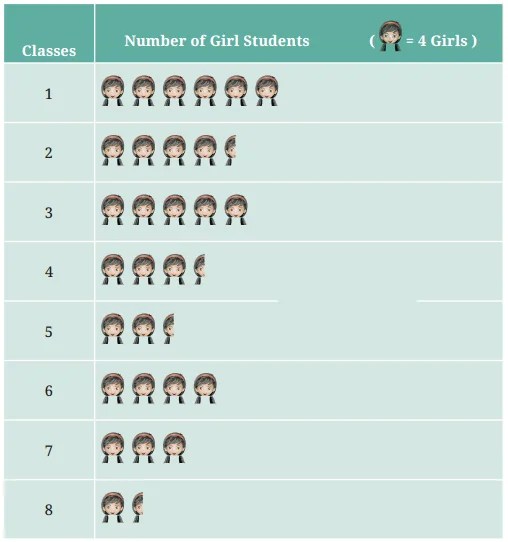
Observe this pictograph and answer the following questions:
(a) Which class has the least number of girl students?
Solution:
Class 8 has the least number of girl students.
(b) What is the difference between the number of girls in Class 5 and 6?
Solution:
Number of girls in class 5 = 4 + 4 + 2 = 10
Number of girls in class 6 = 4 + 4 + 4 + 4= 16
∴ Difference = 16 – 10 = 6
(c) If 2 more girls were admitted in Class 2, how would the graph change?
Solution:
Number of girls in class 2 = 4 + 4 + 4 + 4 + 2 = 18
If 2 more girls are added, then,
Number of girls in class 2 = 18 + 2 = 20
Therefore, new graph would be:

(d) How many girls are there in Class 7?
Solution:
Number of girls in class 7 = 4 + 4 + 4 = 12
Question 8.
Mudhol Hounds (a type of breed of Indian dogs) are largely found in North Karnataka’s Bagalkote and Vijaypura districts. The government took an initiative to protect this breed by providing support to those who adopted these dogs. Due to this initiative, the number of these dogs increased. The number of Mudhol dogs in six villages of Karnataka are as follows
Village A: 18, Village B : 36, Village C : 12, Village D : 48, Village E : 18, Village F: 24
Prepare a pictograph and answer the following questions:
(a) What will be a useful scale or key to draw this pictograph?
(b) How many symbols will you use to represent the dogs in Village B?
(c) Kamini said that the number of dogs in Village B and Village D together will be more than the number of dogs in the other 4 villages. Is she right? Give reasons for your response.
Solution:
Pictograph
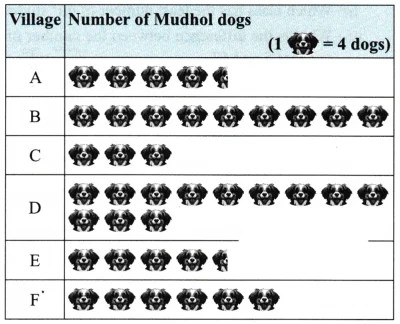
(a) 1 symbol = 4 dogs
(b) 9 symbols each representing 4 dogs.
(c) Number of dogs in village B = 36
Number of dogs in village D = 48
Total number of dogs in village B and village D = 36 + 48 = 84
Total number of dogs in other 4 villages = 18 + 12 + 18 + 24 = 72
Clearly, the number of dogs in village B and village D together is more than the total number of dogs in other 4 villages.
So, Kamini is right.
Question 9.
A survey of 120 school students was conducted to find out which activity they preferred to do in their free time.
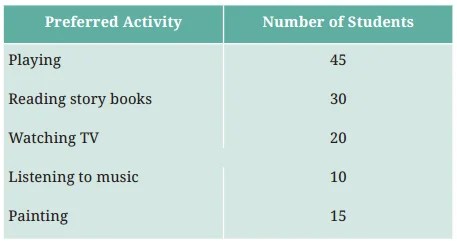
Draw a bar graph to illustrate the above data taking the scale of 1 unit length = 5 students. Which activity is preferred by most students, other than playing?
Solution:

Other than playing, reading story books is preferred mostly by students.
Question 10.
Students and teachers of a primary school decided to plant tree saplings in the school campus and in the surrounding village during the first week of July. Details of the saplings they planted are as follows:

(a) The total number of saplings planted on Wednesday and Thursday is _________.
(b) The total number of saplings planted during the whole week is _________.
(c) The greatest number of saplings were planted on _________
and the least number of saplings were planted on _________.
Why do you think that is the case? Why were more saplings planted on certain days of the week and less on others? Can you think of possible explanations or reasons? How could you try and figure out whether your explanations are correct?
Solution:
(a) The total number of saplings planted on Wednesday and Thursday is 30 + 40 = 70.
(b) The total number of saplings planted during the whole week is
52 + 40 + 30 + 40 + 50 + 60 + 40
= 312
(c) Do it yourself.
Question 11.
The number of tigers in India went down drastically between 1900 and 1970. Project Tiger was launched in 1973 to track and protect tigers in India. Starting in 2006, the exact number of tigers in India was tracked. Shagufta and Divya looked up information about the number of tigers in India between 2006 and 2022 in 4-year intervals. They prepared a frequency table for this data and a bar graph to present this data, but there are a few mistakes in the graph. Can you find those mistakes and fix them?
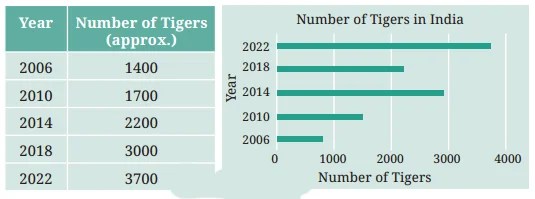
Solution:
(i) The number of tigers (approximately) is 1400 in 2006. But in the bar graph, if is shown less than 1000 (bar is drawn and finished before 1000)
(ii) In 2014, the number of tigers is 2200 as given in the frequency table. But in the bar graph, if is shown close to 3000 (bar is approaching 3000).
(iii) In 2018, the number of tigers is 3000 as given in the frequency table. But in the bar graph, if is in correct (bar is very close to 2000).
The correct bar graph is shown below:

4.5 Artistic and Aesthetic Considerations Figure it Out (Page 103)
Question 1.
If you wanted to visually represent the data of the heights of the tallest persons in each class in your school, would you use a graph with vertical bars or horizontal bars? Why? _
Solution:
To visually represent the data of the heights of tallest persons in each class, bar graph with vertical bars is used. Because, it is more intuitive and visually appealing to represent heights which are measured upwards from the ground, using bar graphs that have vertical bars.
Question 2.
If you were making a table of the longest rivers on each continent and their lengths, would you prefer to use a bar graph with vertical bars or with horizontal bars? Why? Try finding out this information, and then make the corresponding table and bar graph! Which continents have the longest- rivers?
Solution:
For making a table of the longest rivers on each continent and their lengths, bar graph with horizontal bars is used. This is because the length that are parallel to the ground, are usually best representation using bar graphs with horizontal bars.